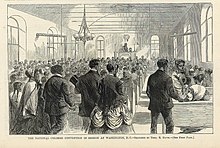 National Colored Convention, Washington, D.C., 1869 | |
| Nickname | Black Conventions Movement |
|---|---|
| Formation | 1830 |
| Purpose | Civil rights activism |
| Location |
|
Key people | Richard Allen |
The Colored Conventions Movement, or Black Conventions Movement, was a series of national, regional, and state conventions held irregularly during the decades preceding and following the American Civil War. The delegates who attended these conventions consisted of both free and formerly enslaved African Americans, including religious leaders, businessmen, politicians, writers, publishers, editors, and abolitionists. The conventions provided "an organizational structure through which black men could maintain a distinct black leadership and pursue black abolitionist goals."[1] Colored conventions occurred in thirty-one states across the United States and in Ontario, Canada. The movement involved more than five thousand delegates[2][page needed] and tens of thousands of attendees.[3]
The minutes from these conventions show that Antebellum African Americans sought justice beyond the emancipation of their enslaved countrymen: they also organized to discuss labor, health care, temperance, emigration, voting rights, the right to a trial by jury, and educational equality.[4][page needed] The Colored Conventions Movement antedated the founding of any formal anti-slavery movement in the United States.[2][page needed]
The conventions significantly increased in number following the Civil War.[5] The Antebellum and postwar colored conventions were the precursors to larger, 20th-century African-American organizations, including the Colored National Labor Union, the Niagara Movement, and the National Association for the Advancement of Colored People (NAACP).[6][page needed]
- ^ Yee, Shirley J. (1992). Black Women Abolitionists, A Study in Activism, 1828–1860. Knoxville: University of Tennessee Press. p. 143. ISBN 0870497367.
- ^ a b Casey, Jim (2021). Foreman, P. Gabrielle; Casey, Jim; Patterson, Sarah Lynn (eds.). The Colored Conventions Movement: Black Organizing in the Nineteenth Century. Chapel Hill, North Carolina: University of North Carolina Press. ISBN 978-1-4696-5426-3. Archived from the original on April 7, 2022. Retrieved April 5, 2022.
- ^ "About the Colored Conventions". Archived from the original on April 26, 2014. Retrieved April 26, 2014.
- ^ "Colored Conventions Project". Archived from the original on April 26, 2014. Retrieved April 26, 2014.
- ^ "Home". Colored Conventions Project. Archived from the original on December 19, 2021. Retrieved December 19, 2021.
- ^ Bell, Howard. Minutes and Proceedings of the Negro Convention Movement. Argo. Archived from the original on April 16, 2014. Retrieved April 26, 2014.
